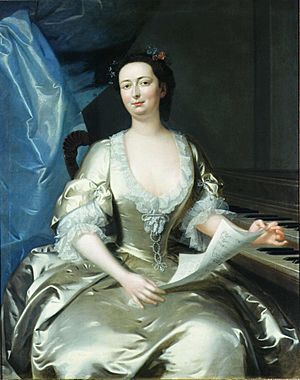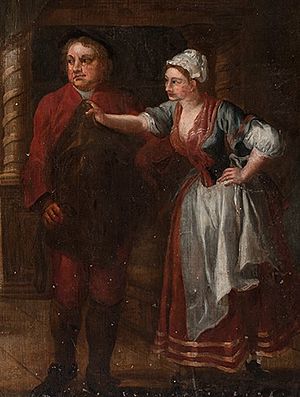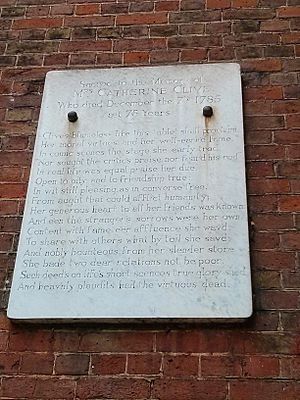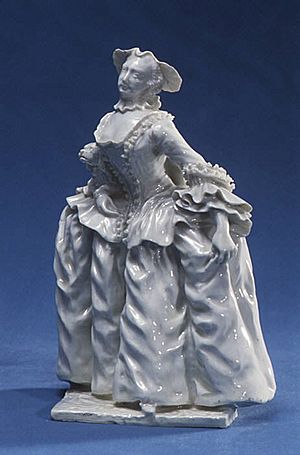Kitty Clive facts for kids
Quick facts for kids
Kitty Clive
|
|
|---|---|
 |
|
| Born | 5 November 1711 |
| Died | 6 December 1785 |
| Occupation | Actor, singer, playwright |
Catherine Clive (born Raftor; 5 November 1711 – 6 December 1785), known as Kitty Clive, was a famous British actress and singer. She was a top star in plays and musical shows from 1728 to 1769. Kitty Clive helped create new kinds of English musical theatre. She was known for singing in grand operas, like those by George Frideric Handel, and for funny roles in ballad operas. Many pictures of her were made and sold. Kitty Clive also spoke up for women's rights during her career.
In the late 1740s, she faced some challenges. To win back public support, she started making fun of herself on stage. This made her very popular again, and she became the top comedienne until she retired in 1769.
Contents
Early Life and Theatre Debut
Kitty Clive was the daughter of William Raftor, who came from Kilkenny, Ireland. Her mother was Elizabeth Daniell. Historians are not fully sure about her exact birth date or her first name. Kitty Clive later wrote that she was born on 15 November 1711.
Kitty Clive began performing at the Drury Lane Theatre. This happened after a play called The Beggar's Opera became very popular in 1728. The manager of Drury Lane, Colley Cibber, wanted to find his own young singing actress. Kitty Clive auditioned and got the part. Her singing teacher, Henry Carey, helped her create her first stage roles.
Kitty Clive was a very talented and trained musician. She made her official debut on 2 January 1729, playing Dorinda in The Tempest. She sang a beautiful song called ‘Dear pretty Youth’. Soon, English songs became a big part of her performances. Later that month, Cibber launched a new type of musical play called Love in Riddle. Kitty Clive played a funny part in it. Her singing was so charming that it saved the play from being a failure.
Breakthrough in Ballad Opera
Kitty Clive's big success in musical plays came two and a half years later. She first played Nell in The Devil to Pay on 6 August 1731. This play was put on by a summer theatre group. An Irish actor, Charles Coffey, helped turn an old comedy into this musical. He chose the songs and wrote the lively words for Kitty Clive.
In the play, Nell was an abused wife. But Kitty Clive's performance changed the role. She made Nell a spirited heroine who charmed everyone. To show off her character, the play was made shorter for the regular season. It ended with a big song for Kitty Clive and Charles Stoppelaer. During the 1730s, a painter named Francis Hayman painted Kitty Clive as Nell. This large painting was very famous. The musical version of The Devil to Pay was later performed in other countries. It helped start new types of musical theatre in Paris and Leipzig.
Rising Stardom and Challenges
After Kitty Clive became famous as Nell, writers like Henry Fielding started creating new funny plays for her. Fielding's plays for Clive were different from her earlier ones. They used common tunes instead of grand songs. His characters for Clive were often bold and clever women.
Fielding's first main role for Clive was in The Covent Garden Tragedy in 1732. This play was not popular and closed quickly. Fielding then quickly put on a musical version of Molière’s The Mock Doctor. This play was a hit. It started a new trend for Clive: playing smart female characters in French comedies. Fielding continued to write roles for her, like clever chambermaids. From 1733, many artists started printing pictures that looked like Kitty Clive.
Theatre Disputes and Personal Life
In 1733, Kitty Clive had her first big disagreement with theatre managers. Theophilus Cibber, a manager's son, caused many actors to leave Drury Lane. Kitty Clive stayed at Drury Lane, possibly to get new roles. Henry Fielding also stayed and kept writing plays for her.
During this time, the press sometimes criticized Clive. But Fielding defended her, praising her talents. Kitty Clive was first listed as 'Mrs. Clive' on a theatre bill in October 1733. She had married George Clive on 30 March 1731. He was a lawyer and uncle to the famous Robert Clive. This marriage helped Kitty gain a respectable name.
In 1734, James Miller became the main writer for Clive's plays at Drury Lane. Miller wrote clever parts and witty endings for her. One of her most famous songs, ‘Life of a Beau’, came from his play The Coffee House (1738). Henry Carey wrote the music for this song.
In 1736, Kitty Clive again disagreed with Theophilus Cibber. He wanted to give roles meant for her to his new wife, Susannah. Kitty Clive fought Cibber in the newspapers for weeks. She finally won over the audience on 31 December 1736 with a powerful speech on stage. This showed how strong her presence was as a performer.
Peak of Stardom
From 1738 to 1743, Kitty Clive was at the peak of her fame as Britain's top singer. Her music and plays were popular across the country. The play Comus (1738), which featured Clive, was a huge success in London and Dublin. While in Dublin, Clive learned a song in Irish Gaelic. She then performed it on a British stage, which was a very rare and important event.
In London, Clive also became a leading actress in Shakespearean comedies. Her role as Portia in The Merchant of Venice (1741) became legendary. The famous composer George Frideric Handel even wrote a special song for her in 1740. He then hired her to lead his opera company in 1743. Handel wrote the role of Delilah in Samson specifically for Clive. He also gave her a short solo in Messiah.
Career Challenges and New Roles
By the early 1740s, Kitty Clive was the highest-paid actor at Drury Lane. But this led to a major problem. The theatre manager, Charles Fleetwood, was a gambler. He started using the actors' wages to pay his debts.
By 1743, Clive was in a difficult situation. She, along with other stars like Charles Macklin and David Garrick, encouraged actors to leave. However, a law from 1737 meant there were only two licensed theatres. The managers of these theatres worked together. They refused to hire the rebel actors or offered them very low pay. Clive and her group went to Covent Garden Theatre, but the manager there also paid very little and often didn't pay at all.
A public argument started in the newspapers. Clive defended herself in a pamphlet called The Case of Mrs. Clive (1744). In response, Fleetwood said Clive and Garrick were earning too much. He revealed Clive's yearly income, which was about £700 (a lot of money back then). This made some people think Clive was greedy.
New Stage Characters
David Garrick, who became a co-manager of Drury Lane, worked to help Clive regain her popularity. In 1749, Garrick created a new character for Clive called ‘Mrs Riot’ in his play Lethe. This role was meant to make fun of Clive's supposed flaws. As Mrs. Riot, Clive played a strong, independent woman. This role, along with Garrick's support, made Lethe a very popular play. Clive found new success playing funny, older characters. These roles often showed her as a bold and sometimes over-the-top lady.
Since 1740, Clive had spoken out against unfair treatment of women, especially women writers. Her first play that she wrote herself, The Rehearsal, or Bayes in Petticoats (1750), supported female playwrights. She also sometimes starred in new comedies written by women, such as Frances Sheridan’s The Dupe (1763). After 1750, Clive used her musical talent for comedy. She would make fun of herself or imitate famous Italian singers.
Clive's own writings, like her 1744 pamphlet and letters, give important details about her career. She also wrote her own short plays for her benefit nights.
Retirement and Legacy
Kitty Clive retired from the stage in 1769. By 1754, she had moved into a cottage called Little Strawberry Hill. Her friend Horace Walpole provided the cottage for her. He called it "Clive's Den." Walpole often wrote about her in his letters, saying she was lively and fun.
Kitty Clive was very popular at parties and social gatherings. The writer Samuel Johnson once said of her, "Clive, Sir, is a good thing to sit by; she always understands what you say." She passed away on 6 December 1785. She was buried in the churchyard at St Mary's Church, Twickenham. A plaque with a poem written by her friend, actress Jane Pope, is on the church wall to remember her.
Selected Performances
- Rosella in The Village Opera by Charles Johnson (1729)
- Phillida in Love in a Riddle by Colley Cibber (1729)
- Kitty in The Humours of Oxford by James Miller (1730)
- Dulceda in Bayes's Opera by Gabriel Odingsells (1730)
- Nell in The Devil to Pay by Charles Coffey (1731)
- Chlose in The Lottery by Henry Fielding (1732)
- Mercury in Timon in Love by John Kelly (1733)
- Maria in The Man of Taste by James Miller (1735)
- Liberia in The Universal Passion by James Miller (1737)
- Violetta in Art and Nature by James Miller (1738)
- Miss Kitty in The Coffee House by James Miller (1738)
- Rosamond in Rosamond by Thomas Arne (1740)
- Kitty in High Life Below Stairs by James Townley (1759)
- Muslin in The Way to Keep Him by Arthur Murphy (1760)
- Lady Beverly in The School for Lovers by William Whitehead (1762)
- Sift in The Widowed Wife by William Kenrick (1767)
- Mrs Winifred in The School for Rakes by Elizabeth Griffith (1769)
Images for kids
-
Figure in Bow porcelain, c. 1750, as Mrs Riot. With its pair of Henry Woodward, perhaps the earliest English porcelain figures.
See also
 In Spanish: Kitty Clive para niños
In Spanish: Kitty Clive para niños






